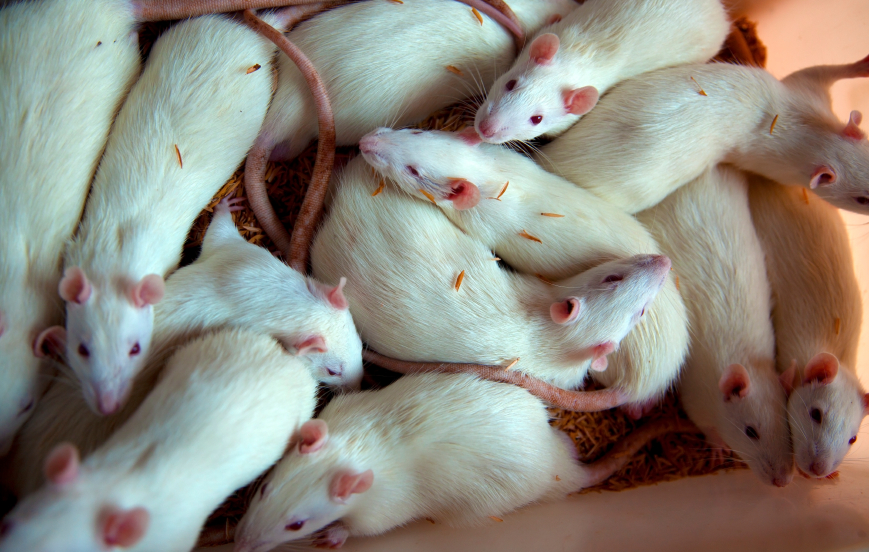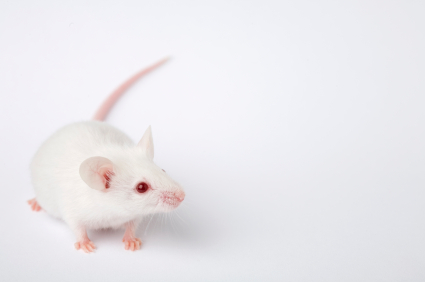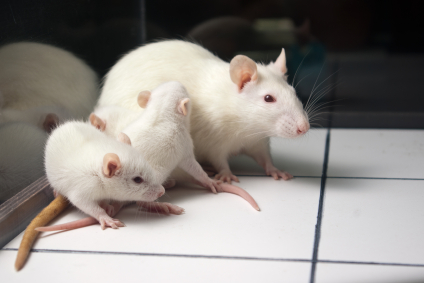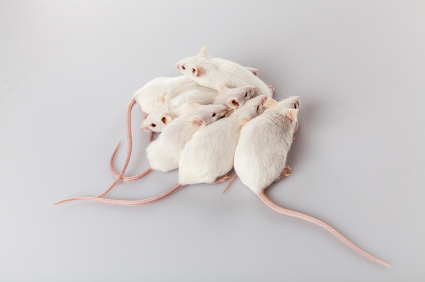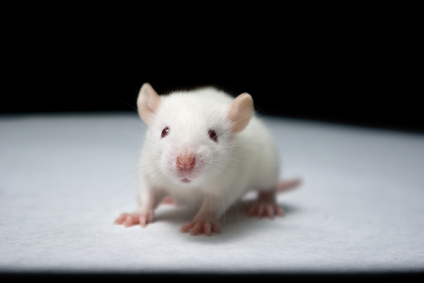Short Telomeres in a Rat Model of Depression, Lithium Reverses Abnormality
Telomeres are repeated DNA sequences that sit at the end of chromosomes and protect them during cell replication. Telomeres get shorter with aging and with stressors or psychiatric illnesses. Researcher Alexandre Mathe and colleagues recently found that in a line of rats bred to be more susceptible to stress and depression-like behavior, hippocampal telomeres were shorter than in normal rats or rats bred to be less susceptible. The susceptible rats also had lower levels of enzymes that maintain telomere length. Both telomerase activity and Tert (telomerase reverse transcriptase) expression were reduced in the susceptible rat compared to the other rats. However, lithium reversed the low levels of telomerase activity and Tert expression.
Editor’s Note: Lithium increases hippocampal volume in people, and also increases human telomerase. Researcher Lina Martinsson reported in 2013 that lithium increases telomere length in white cells. Now lithium has increased hippocampal telomerase in a rat model of depression. Short telomeres are associated with aging and increased vulnerability to a wide range of medical and psychiatric disorders. Since people with bipolar disorder are prone to memory problems, medical problems, and short telomeres, they might want to talk to their physician about including lithium in their treatment regimen, if they are not already taking it.
Mania-like State Produced in Rats By Kindling the Lateral Hypothalamus
The lateral hypothalamus is responsible for certain physiological functions (the sleep-wake cycle, appetite, energy expenditure, and sexual functions) that are disrupted during mania. At the 2014 meeting of the International Society for Bipolar Disorders, researcher O. Abulseoud et al. presented evidence that a mania-like state could be produced in rats by “kindling” the lateral hypothalamus with an electrode.
The kindled rats engaged in more motor activity; less rest; more sexual self-stimulation; excessive rearing, feeding, and grooming; and more ethanol consumption. Non-kindled rats (and those kindled in other areas such as the nucleus accumbens shell and the infralimbic cortex) did not engage in this combination of behaviors.
To test the similarity between the mania-like behaviors and human mania, the researchers treated the kindled rats with saline solution, lithium, or valproic acid. Lithium and valproic acid reduced these behaviors significantly compared to the saline solution. These treatments also produced long-term increases in mRNA for certain genes (Per1 and CLOCK) that are dysregulated in people with mania.
This animal model may become useful in future research on manic psychopathology in humans.
Depression May Not Be All in Your Head
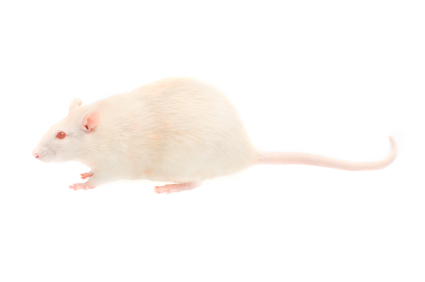 Repeated social defeat stress (when an intruder mouse is repeatedly threatened by a larger mouse defending its home territory) is often used as a model to study human depression. Animals repeatedly exposed to social defeat stress start to exhibit depression-like behaviors such as social avoidance and loss of interest in sucrose. Georgia Hodes, a researcher at Mount Sinai School of Medicine, reported at a recent scientific meeting that repeated defeat stress–induced behavior was blocked when IL-6, an inflammatory cytokine released by white blood cells in the blood, was inhibited. The central nervous system did not appear to be involved.
Repeated social defeat stress (when an intruder mouse is repeatedly threatened by a larger mouse defending its home territory) is often used as a model to study human depression. Animals repeatedly exposed to social defeat stress start to exhibit depression-like behaviors such as social avoidance and loss of interest in sucrose. Georgia Hodes, a researcher at Mount Sinai School of Medicine, reported at a recent scientific meeting that repeated defeat stress–induced behavior was blocked when IL-6, an inflammatory cytokine released by white blood cells in the blood, was inhibited. The central nervous system did not appear to be involved.
Interestingly, mice with more white blood cells and more IL-6 release at baseline (prior to the social defeat stress) were more likely to show the defeat-stress depressive behaviors.
Editor’s Note: The higher number and greater reactivity of white blood cells seen in these mice could be a clinical marker of vulnerability to defeat stress, and such findings are worthy of study in human depression. White blood cells are critical to fighting infection and sometimes their overactivity can contribute to inflammation. In meta-analyses, a subgroup of depressed patients consistently show elevated inflammatory markers (including IL-1, IL-6, TNF alpha, and CRP), and it remains to be seen whether these markers of inflammation are generated in the central nervous system or come from white blood cells in the blood, and whether their targeted suppression could be a new route to antidepressant effects (as in the study of defeat stress in mice).
Information from Environmental Experiences Can Be Passed on in Dad’s Sperm
Contrary to all common sense, researcher Brian Dias showed that when rats that were future fathers learned to associate an odor with a shock, this learning could be passed on to the next generation when the father mated with a female rat that had not learned the same association.
It turns out that the next generation of rat pups shows increased behavioral reactivity to the odor in a process different from the fear conditioning they might exhibit if they learned to avoid the odor through their own experiences.
Presumably, the pup is somehow programmed through an epigenetic modification of the father’s sperm to grow more neurons from the nose to the olfactory bulb that specifically react to the odor its father feared, and not to other odors. Miraculously, when the second generation pup grows up and fathers a third generation pup, the new pup also shows increased behavioral sensitivity to that specific odor. How the odor information from the first generation is represented in the fathers’ sperm and passed on to their descendants is still a complete mystery.
There are also new data that a father rat fed a diet deficient in folic acid (vitamin B9) will sire offspring with more congenital malformations. Additionally, an obese father rat fed a diet that includes extra fat calories will sire pups that become obese as adults even when fed a normal milk diet from a svelte mother before weaning and then fed a normal diet after weaning.
Mothers’ behavior usually gets most of the credit and/or blame for her children’s behavior, but now it looks like fathers’ diet or behavior (even before they have children) may have lasting consequences for their offspring.
Conditioned Fear Can Be Transmitted Transgenerationally in Rodents
Scientists often use fear conditioning to study rodents’ learning and behavior. If a particular stimulus (such as a light, a sound, or an odor) is presented paired with the delivery of a mild shock, the animal begins to associate the stimulus with the shock and will freeze when it is presented and avoid the stimulus.
New research shows that if a pregnant rat (known as a dam) goes through fear conditioning that pairs an odor with a shock, the rat’s offspring will also avoid that odor into adolescence. Even if the pups are raised by a different mother who never went through the fear conditioning, they still avoid the odor into adolescence, showing that they do not learn the behavior through watching their mother.
The conditioning is specific to the particular odor, such that a different odor not used in the fear conditioning does not evoke a heightened reaction from the pups. It appears that the pup learns the fear through chemical signals, such as alarm pheromones that can pass through the placenta.
Rats Learn Fear Conditioning From One Another
Rats who are taught to associate a light with an electric shock learn to avoid the light. This process is known as conditioned fear. New research shows that if one rat watches another rat go through fear conditioning, the observing rat will also show the effects of fear conditioning. It will also avoid the light, but only if it had previous experience with fear conditioning. It appears that rats have the ability to learn from other rats’ painful experiences.
Memories Erased From the Amygdala of Rats
A recent study found that in rodents, new negative memories can be deleted. Rats in the study were taught conditioned avoidance. For example, a light or a sound would signal that a mild shock would be delivered through the floor of the chamber in which the rat was housed. The rat could avoid the shock by running to the other side of the cage. Once the rat learned that the light or sound signal preceded a shock, the rat began switching sides when the light or sound cue appeared, even if no shock was given. This response to the conditioned signal is evidence that learning has taken place and is stored in memory.
The researchers found that when a rat formed a new conditioned avoidance memory, there were increases in cyclic AMP response element binding (CREB) protein in specific neurons in the rat’s lateral amygdala (about 20% of the total number of neurons in the amygdala). Then, using extraordinarily sophisticated molecular biology, the investigators attached a diphtheria toxin onto the CREB protein, which caused the specific neurons involved in the conditioned avoidance learning to be killed while the other neurons in the amygdala (those not associated with the new memory) survived. As a result, the animals couldn’t remember anything about the specific avoidance learning, but other memories could be formed and remained accessible.
Obviously, this type of approach is not yet pertinent to clinical therapeutics in humans, but this research does teach us that in rodents, a conditioned avoidance memory activates a subset of the neurons in the lateral amygdala, and the elimination of these neurons eliminates specific learned memories, but not other types of learning.
Ultimately this kind of preclinical data may lead to novel clinical approaches to specific traumatic memories that are associated with post-traumatic stress disorder (PTSD).


